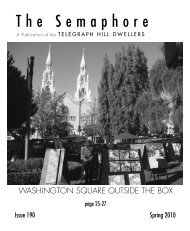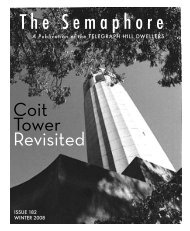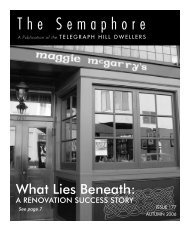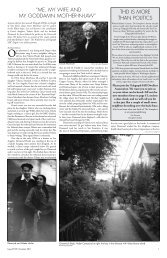Issue 188, Summer 2009 - Telegraph Hill Dwellers
Issue 188, Summer 2009 - Telegraph Hill Dwellers
Issue 188, Summer 2009 - Telegraph Hill Dwellers
- No tags were found...
You also want an ePaper? Increase the reach of your titles
YUMPU automatically turns print PDFs into web optimized ePapers that Google loves.
PARKS, TREES, & BIRDS REPORTCoit Tower:North Slope Forest Management &Upper Slope View Restorationby Judy IrvingOn September 30th, twenty aging Montereycypress trees will be removed from<strong>Telegraph</strong> <strong>Hill</strong> near the Coit Tower parkinglot, and on Saturday, October 3rd, PG&E volunteerswill help remove brush and prepare the clearedareas for planting. But why, in a city with so few trees,are any being cut down at all? Here’s the scoop:If you’ve been up to Coit Tower recently, you’veno doubt seen tourists milling around the parkinglot, confused and perplexed because they can’t seethe view. Further, the Monterey cypress trees upthere are not happy—they’ve been “topped” for toolong. The Pioneer Park Project, the same communitygroup that installed the new stairways and createdthe south lawn, is moving ahead with a plan thatwill allow some of the cypresses to keep growingto their natural heights, while also removing sometrees to provide three new view corridors. The ailingcypresses will be replaced by native plants that don’tgrow so high. Only one native-plant view corridorexists now, toward the Golden Gate Bridge. The newcorridors will open up views to the northwest, north,and northeast.Joe Butler, former chair of THD’s Parks & TreesCommittee, gave me a tour of the existing nativetrees and shrubs that have been planted around CoitTower in recent years, and the landscape designersof the new plan showed me which trees would beremoved and which ones would be allowed to growto full height. Lord knows, I’m not in favor of cuttingdown trees willy-nilly, but this is a well-thought-outproject with earlier experimental plantings to learnfrom. Below are some answers to questions I hadafter making my site visits and reading the project’stree report:1) There are no “significant trees” in the projectarea, since they are all more than the required distancefrom the right-of-way. There are no “landmark”trees either, as far as we know.2) I asked why some of the “fair” condition treeswere marked for removal, while some of the “all butdead” trees were not marked for removal. Answer:Trees are being removed from three “finger” areas toopen up views to the northwest, north, and northeast.In the tree report, while some of the twentytrees marked for removal are “fair,” all of them werejudged to have “poor” restoration potential (i.e., theydo not have good potential to grow into healthy, wellshapedcypresses, even with pruning). The remaining“all but dead” cypresses which are not in view corridorswill potentially be candidates for replacement incoming years, but not now.3) The project is following the tenets of “adaptivemanagement,” i.e., go slowly, see what worksand what doesn’t, and adapt strategies to what actuallyworks on the <strong>Hill</strong> (while replanting with nativeshrubs and trees).4) Some of the cypresses framing the view corridorswill be allowed to grow tall, even those that havebeen topped in the past. Hopefully they will fill outand look better as they are allowed to grow, but theymay need pruning as well. There is one tree with aninteresting gnarly trunk that will be allowed to growcontinued on page 2928 <strong>Issue</strong> #<strong>188</strong> • <strong>Summer</strong> <strong>2009</strong>













